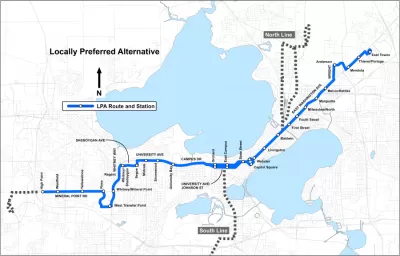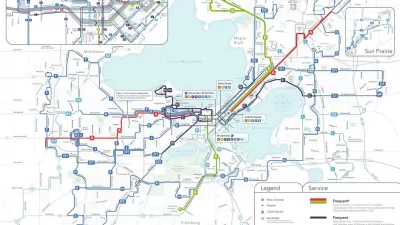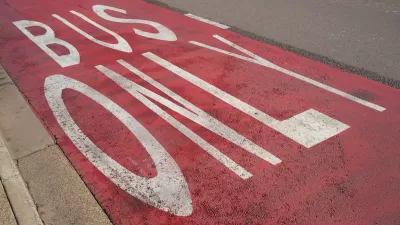Some portions of the bus rapid transit (BRT) system planned for Madison, Wisconsin will resemble the fully realized BRT systems more common in other parts of the world.

"Madison’s proposed $160 million Bus Rapid Transit system may run its special buses on dedicated center lanes with boarding stations on medians on some of the city’s main thoroughfares," reports Dean Mosiman from Wisconsin.
The center lane would only be built on some portions of the BRT route, according to Mosiman, wile other stretches would run on side lanes while mixing with car traffic. The dedicated center lanes, proposed for "Blair and Milwaukee streets and other stretches of East Washington Avenue on the East Side and on Whitney Way and Mineral Point Road on the West Side," would deliver more consistent service while also preserving bike lanes and street parking on those stretches, according to the article.
Back in March, the Madison City Council and the Greater Madison Area Metropolitan Planning Organization approved a preferred alternative route for the line, which will include 27 stations served by five- to 15-minute headways running from 5 am to midnight on weekdays, and 15- to 30-minute headways from 7 am to 11 pm on weekends.
"About 83,000 residents would live within a half-mile of stations, while about 110,000 jobs would be within that distance," according to Mosiman.
Madison Metro Transit planners are making refinements to the plan while waiting for approval for $107 million in federal money toward the total $160 million needed for the project.
FULL STORY: Madison may push Bus Rapid Transit system to center lanes

Alabama: Trump Terminates Settlements for Black Communities Harmed By Raw Sewage
Trump deemed the landmark civil rights agreement “illegal DEI and environmental justice policy.”

Study: Maui’s Plan to Convert Vacation Rentals to Long-Term Housing Could Cause Nearly $1 Billion Economic Loss
The plan would reduce visitor accommodation by 25% resulting in 1,900 jobs lost.

Why Should We Subsidize Public Transportation?
Many public transit agencies face financial stress due to rising costs, declining fare revenue, and declining subsidies. Transit advocates must provide a strong business case for increasing public transit funding.

Paris Bike Boom Leads to Steep Drop in Air Pollution
The French city’s air quality has improved dramatically in the past 20 years, coinciding with a growth in cycling.

Why Housing Costs More to Build in California Than in Texas
Hard costs like labor and materials combined with ‘soft’ costs such as permitting make building in the San Francisco Bay Area almost three times as costly as in Texas cities.

San Diego County Sees a Rise in Urban Coyotes
San Diego County experiences a rise in urban coyotes, as sightings become prevalent throughout its urban neighbourhoods and surrounding areas.
Urban Design for Planners 1: Software Tools
This six-course series explores essential urban design concepts using open source software and equips planners with the tools they need to participate fully in the urban design process.
Planning for Universal Design
Learn the tools for implementing Universal Design in planning regulations.
Smith Gee Studio
Alamo Area Metropolitan Planning Organization
City of Santa Clarita
Institute for Housing and Urban Development Studies (IHS)
City of Grandview
Harvard GSD Executive Education
Toledo-Lucas County Plan Commissions
Salt Lake City
NYU Wagner Graduate School of Public Service





























